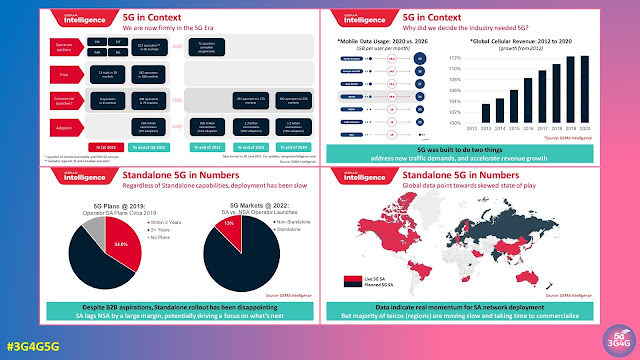I recently participated in a webinar, discussing one of my favourite topics, 5G Standalone (5G SA). If you do not know about 5G SA, you may want to quickly watch my short and simple video on the topic here.
Next week I am participating in a webinar, "Open for Debate: Is the Industry Moving Fast Enough on Standalone 5G?" along with Peter Jarich, Radhika Gupta and Tim Hatt. Hope to see you there: https://t.co/TQ8Aa5LXYP #3G4G5G #5G #5GNetworks #5GTechnology #5GNR #5GStandalone #5GSA pic.twitter.com/Rd7hGvvCNe
— Zahid Ghadialy (@zahidtg) July 15, 2022
Last year I blogged about GSA's 5G Standalone webinar here. That time we were discussing why 5G SA is taking time to deliver, it was sort of a similar story this time. Things are changing though and you will see a lot more of these standalone networks later this year and even early next year.
The slides of the webinar are available here and the video is embedded below:
Here are some of my thoughts on why 5G SA is taking much longer than most people anticipated:
- 5G SA will force operators to move to 5G core which is a completely new architecture. The transition to this is taking much longer than expected, especially if there are a lot of legacy services that needs to be supported.
- Many operators are moving towards converged core with 4G & 5G support to simply the core. This transition is taking long.
- For taking complete advantage of 5G architecture, cloud native implementation is required. Some operators have already started the transition to cloud native but others are lagging.
- 5G SA speeds will be lower than NSA speeds hence some operators who don't have a lot of mid-band spectrum are delaying their 5G SA rollouts.
- Many operators have managed to reduce their latency as they start to move to edge datacentres, hence the urgency for 5G standalone has reduced.
- Most operators do not see any new revenue opportunities because of 5G SA, hence they want to be completely ready before rolling out 5G SA
- Finally, you may hear a lot about not enough devices supporting 5G SA but that's not the device manufacturers views. See this tweet from GSA 👇
#Supporting5Gstandalone
— GSA (@gsacom) July 11, 2022
With 5G SA networks now being launched, GSA is already aware of 842 announced devices with claimed support for 5G SA, up 202% from 278 at the end of 2020.
Full report on: https://t.co/8f1fw4R2fI#5G | #SA | #Devices | #GSA pic.twitter.com/7LEoyasplm
Do you agree with my reasoning? If not, please let me know in the comments.
Related Posts:
- The 3G4G Blog: The Status of 5G Standalone (5G SA) Networks - March 2021
- The 3G4G Blog: What will 5G Standalone deliver?
- The 3G4G Blog: The Politics of Standalone vs Non-Standalone 5G & 4G Speeds
- The 3G4G Blog: 5G Reality Check - Data Rates
- Operator Watch Blog: Germany gets Two 5G Standalone Networks
- The 3G4G Blog: Minimum Bandwidth Requirement for 5G Non-Standalone (NSA) Deployment
- The 3G4G Blog: 5G Dual Connectivity, Webinar and Architecture Overview
- The 3G4G Blog: What about 5G Network Architecture Option 4 (a.k.a. NE-DC) ?
- Free 5G Training: 5G Use Cases
- Free 5G Training: 5G Adverts
- 3G4G: 5G for Absolute Beginners

No comments:
Post a Comment